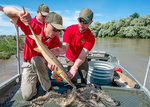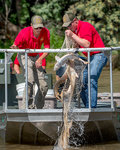Clear, 37° F
Launching into a hot chocolate-colored river, a three-man team began their final search of the spring for a survivor from the Jurassic period.
One shift away from finishing a five-year study, …
This item is available in full to subscribers.
The Powell Tribune has expanded its online content. To continue reading, you will need to either log in to your subscriber account, or purchase a subscription.
If you are a current print subscriber, you can set up a free web account by clicking here.
If you already have a web account, but need to reset it, you can do so by clicking here.
If you would like to purchase a subscription click here.
Please log in to continue |
|





Launching into a hot chocolate-colored river, a three-man team began their final search of the spring for a survivor from the Jurassic period.
One shift away from finishing a five-year study, the crew cast off into the fast-flowing river hoping to capture a record amount of shovelnose sturgeon. They were looking to track the progress of a reintroduction project that began more than two decades ago.
In 1996, Wyoming Game and Fish Department biologists stocked sturgeon in the Bighorn River in an attempt to create a unique sport fishing opportunity for anglers and to return the species to one of their native habitats. Looking at the fish with four fleshy whiskers and body armor leaves no doubt that this is an ancient species.
“It’s a dinosaur,” said Cody Region fisheries biologist Joe Skorupski.
Navigating high water
For the past four years, Skorupski has spent countless hours battling the elements on the river, analyzing the success of the program. Mother Nature hasn’t been helpful.
“Since the start of this project we’ve had high water years. Big water years,” Skorupski said while piloting the department’s custom jon boat against the current.
In spring and early summer, the rush of snow melt carries sediment, causing the river to muddy. Two technicians, Jake Ruthven and Colton Webb, stood at the bow, listening for signs of life on the bottom of the river. Wearing headphones plugged into car battery-sized receivers and holding antennas over the bow of the low-slung vessel, the technicians used hand signals to point out locations to the captain. Each time they detected the sound of a tiny transmitter carried by the fish, a long net was deployed. Like a center and quarterback combo, Ruthven and Webb fed the net off the bow as Skorupski carefully positioned the boat for the perfect set. The team drifted as line fed from large wood spools attached to the nets and doubling as buoys, allowing the net to reach the bottom of the river. Once content that the area was sufficiently covered, the team pulled the nets to reveal their catch.
Sometimes the nets were full with species like sauger, common carp, redhorse and large chubs. But when conditions were right, and with a little luck, the nets would come back full of the underwater dinosaurs — sometimes as many as six to eight at a time.
“Keep them coming. I’m looking for a record day,” Skorupski said as the nets finally revealed multiple sturgeon.
A species adrift
Armor plates hide the species’ soft underbellies. Their long, sleek bodies are perfect for the strongest currents of major river systems in the U.S. From the headwaters of the big muddy Missouri in Montana and the mighty Mississippi in Minnesota to the Gulf of Mexico, the shovelnose is the smallest of the world’s subspecies of sturgeon. Larger species of sturgeon are better known for their salty eggs, served chilled and called caviar. The team of scientists was also looking for eggs on the Bighorn River — just not as an appetizer.
Once taken from the nets, the fish were quickly moved to a large livewell. Each individual was measured, weighed, tagged twice, tested for sex and maturity and then gently released unharmed back to the river. Several untagged fish came in, suggesting the possibility of natural reproduction. But the real search was for females fat with eggs.
When a female — the larger of the species — was caught, Skorupski tested for eggs by carefully inserting a tube attached to a syringe into their bellies. On this day, there were very few signs of females ready to spawn.
It’s not easy to gauge success with the species, which starts its life in a free fall. Eggs hatch after a few days, then the embryos sink to the bottom of the river and begin to drift with the current. Depending on temperature and the river’s flow, the embryos will mature into larvae. Only then will they begin to swim.
Their lifecycle in the Bighorn River is complicated by Yellowtail Dam in southern Montana. Sturgeon embryos need between 60 and 150 miles of drift to mature into the larval stage before hitting Bighorn Lake. In fast water years, the embryos may reach the reservoir too soon, where there is far less of the dissolved oxygen that the young fish need.
Fast water also makes it hard for adults to successfully spawn — and makes it impossible for the Game and Fish team to capture sturgeon in embryonic stages for modeling data.
“We haven’t got our hands on any embryos, mostly due to high waters,” Skorupski said.
As a result, he’s unable to say definitively the species is naturally reproducing in the Bighorn. But there are a lot of fish in the system.
Research to continue
Department biologists are still working to model the drift potential of the river, trying to finish a soon-to-be-released report on flow and temperature as it relates to the success of the sturgeon reintroduction effort.
Radio telemetry transmitters deployed in 2015 and 2016 are now near the end of their battery life and soon will go silent. But just because the five-year study is over doesn’t mean sturgeon are on their own, Skorupski said.
“We’re going to build in monitoring on a multi-year rotation,” he said. “One of the advantages is we can continue to tag individuals for long term monitoring because they live so long.”
Shovelnose sturgeon rarely grow larger than 15 pounds and can potentially live for 30 years or more. It takes males five years to mature and seven years for females to produce eggs, Skorupski said. Even when sexually mature, females only produce young every three years.
Biologists will return to the river to check on fish previously tagged and hope anglers report tag numbers as they are caught. They’ll also continue to look for evidence of recruitment. To assist in future monitoring, all fish stocked in the river have had a forward scute removed. Scutes are sharp, bony, diamond-shaped scales acting as body armor. Finding young recruits in the future with all scutes intact will help prove the fish is naturally reproducing.
The team has found spawning sites, but most are on the lower threshold of suitable drift distance from the reservoir. One spawning site near Worland is 87 miles from Bighorn Lake. And on the final day the team worked a spawn site near Manderson — only 60 miles from the reservoir.
The shovelnose sturgeon study had three main objectives: Identify potential spawning sites and seasonal habitat use in the Bighorn and Nowood rivers; monitor for the presence of embryonic and larval sturgeon downstream of those sites; and to model embryonic and larval development and drift rates to determine locations of larval settlement.
This was the first year of the study that not a single female was found to be exhibiting the tell-tale signs of being ripe for spawning. However, the team tagged 50 sturgeon this year, and despite some difficulties, there’s been a lot of positives discovered during the study.
“We have a lot of fish in the river. We continue to see they are using the habitat all the way from Worland down to the reservoir. What that tells us is it’s suitable habitat,” Skorupski said.
The study shows the the river has a “fairly robust population” with sturgeon of different age groups, he said.
Anglers can enjoy the fruits of the Game and Fish’s labor on the Bighorn River. There are several access points for launching boats and bank fishing opportunities. Sturgeon can be caught on the same type of bait as catfish — insects such as worms and leeches. There’s also a healthy population of sauger in the system.
The Game and Fish plans to continue stocking sturgeon through 2020 and then will re-evaluate the program.